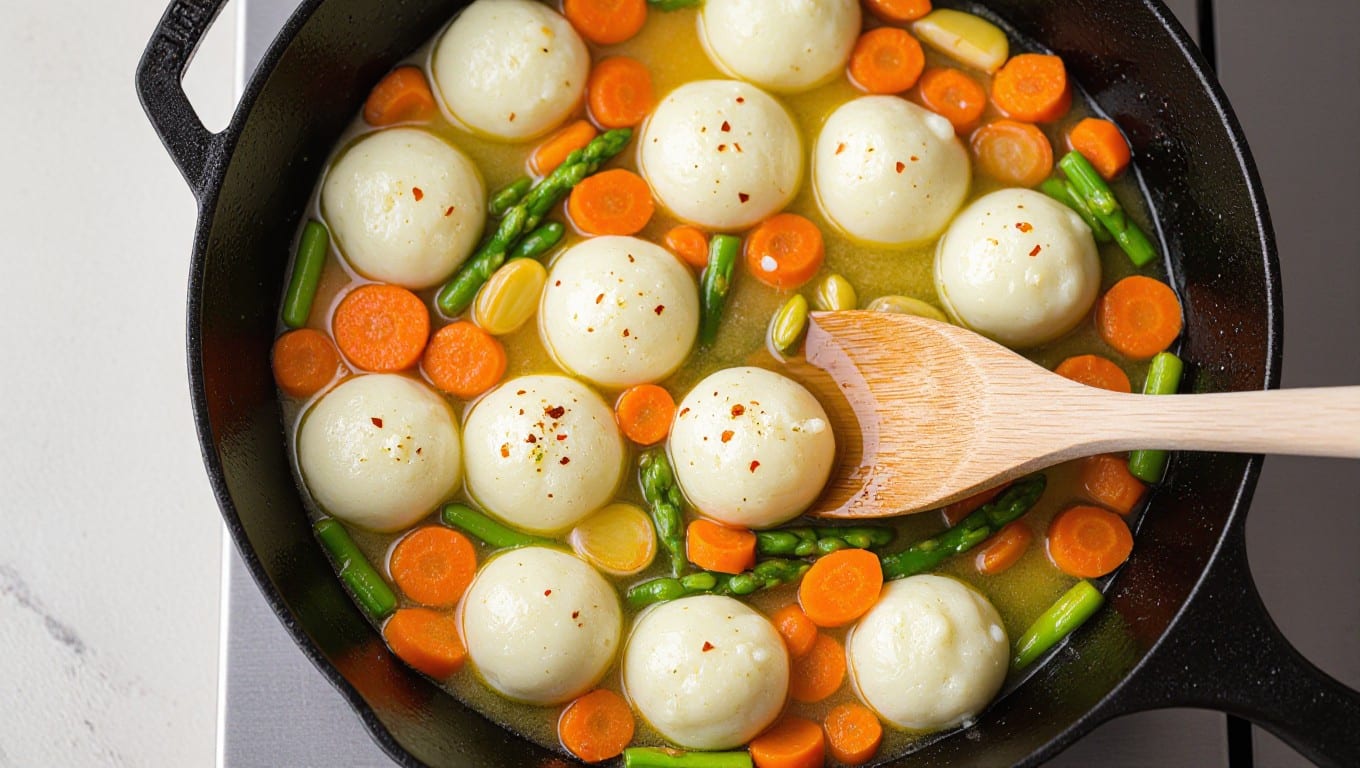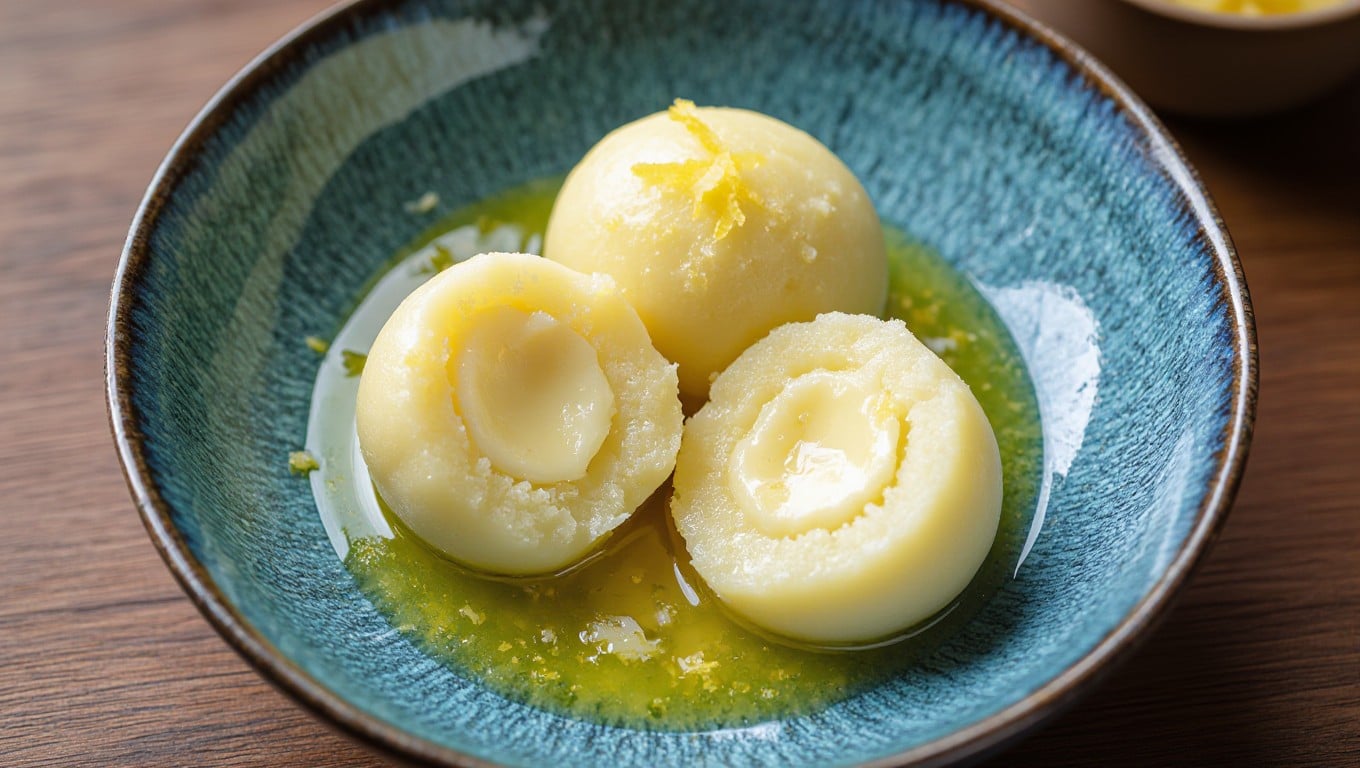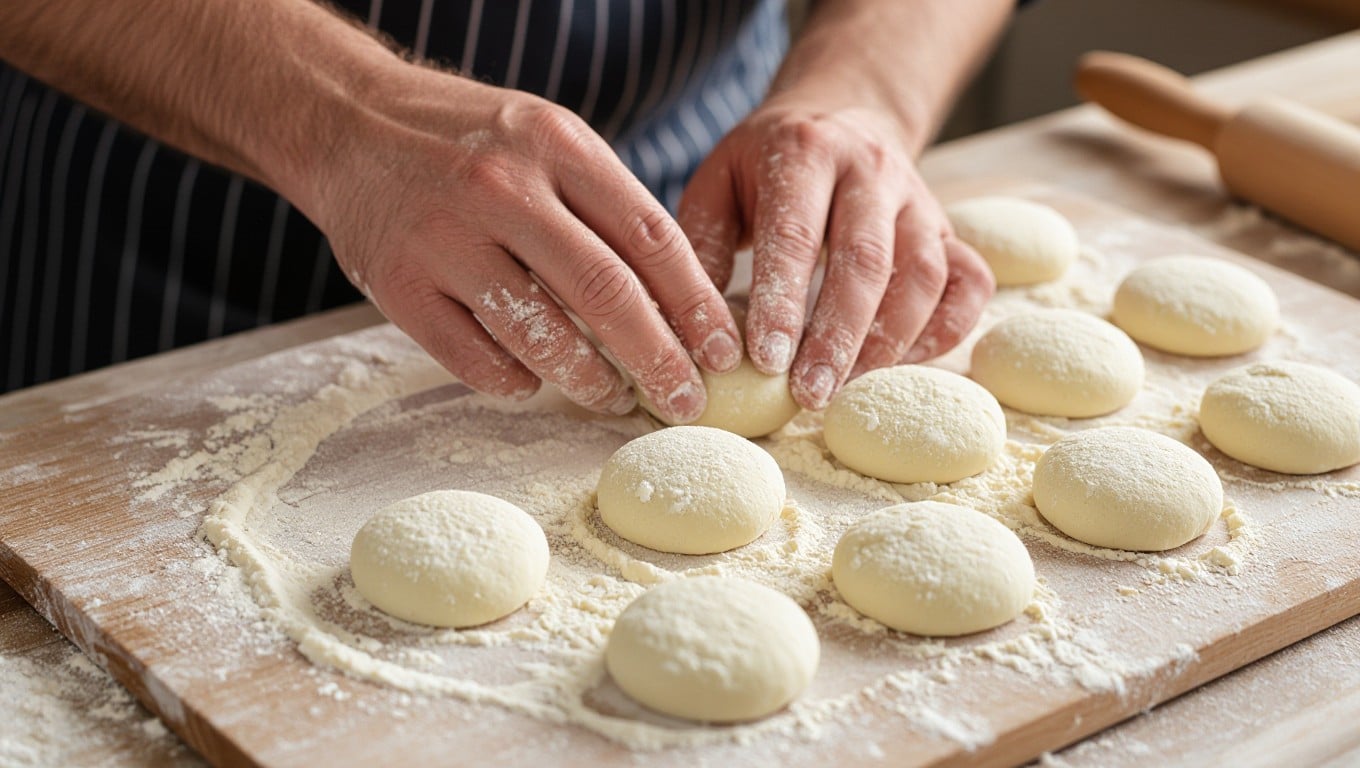This delightful recipe guides you through making light and tender ricotta gnudi infused with bright lemon flavors, perfectly complemented by fresh spring vegetables. As you prepare this dish, you’ll learn how to balance textures and vibrant tastes while avoiding common pitfalls like overly wet dough, which can make the gnudi fall apart. By following each step carefully, you’ll create a fresh, elegant meal that showcases your culinary skills and celebrates seasonal ingredients in a healthy and delicious way.
How to Make Ricotta Gnudi al Limone With Spring Vegetables
- Drain ricotta:
Wrap 2 cups of ricotta in cheesecloth and let it drain in the fridge for 1–2 hours to remove excess moisture. - Make gnudi dough:
In a bowl, mix the drained ricotta, egg, yolk, Parmesan, lemon zest, salt, pepper, and flour until just combined. - Shape and chill:
Scoop the dough, roll into small balls, and place on a semolina-dusted tray. Chill for at least 30 minutes. - Cook the gnudi:
Boil salted water and cook the gnudi for 3–4 minutes until they float to the top. Remove gently with a slotted spoon. - Prepare wilted greens:
Sauté shallots in olive oil, then add spinach or spigarello and cook until just wilted. Set aside. - Cook spring vegetables:
In butter, sauté asparagus, snap peas, and radish slices for 3–4 minutes. Add lemon juice and remove from heat. - Make the sauce:
Melt butter with garlic and chili flakes. Deglaze with white wine and reduce slightly to create a light sauce. - Assemble and serve:
Toss cooked gnudi in the butter sauce. Plate over wilted greens, top with spring vegetables, lemon zest, pine nuts, and basil.

Unveiling Ricotta Gnudi: A Culinary Delight
Ricotta gnudi embody a delicate balance of simplicity and sophistication, offering a lighter, ethereal alternative to traditional gnocchi. The pillowy texture melts effortlessly on your palate, elevated by subtle lemon zest that brightens each bite. Infused with spring vegetables, this dish captures seasonal freshness while maintaining a classic Italian charm that you can appreciate with every forkful.
The Art of Crafting Gnudi
Crafting gnudi requires a gentle touch: mixing ricotta with just enough flour and eggs to bind without overwhelming the lightness is key. You shape the dough into small, rustic pillows and briefly boil them until they float, a sign that you’ve achieved the perfect tender consistency. Each step demands precision, ensuring your gnudi remain supple yet hold their form through cooking.
Choosing the Right Ricotta and Ingredients
Select ricotta with high moisture content and fresh, mild flavor for ideal gnudi texture. Whole milk ricotta provides creaminess that low-fat versions can’t match. Incorporating aged Parmesan adds depth, while fresh herbs like sage or chives introduce vibrant accents that complement the lemon’s brightness. Season your mixture with just enough salt to enhance, avoiding overpowering the delicate base.
Diving deeper, fresh ricotta made within 24 hours of purchase significantly improves the outcome, offering a silkier texture that holds together without excess flour. Opting for artisanal ricotta from small producers often ensures superior quality and flavor nuances compared to mass-market options. Meanwhile, pairing your gnudi with tender spring vegetables like asparagus tips or fava beans enhances both taste and visual appeal, making your dish memorable on every level.
The Symphony of Spring Vegetables
The vibrant medley of spring vegetables elevates the delicate ricotta gnudi with fresh, lively textures and bright, natural flavors. Young peas, asparagus tips, fava beans, and baby carrots each bring a distinctive crispness and subtle sweetness, creating a balanced foundation for the lemon-infused sauce. Integrating these seasonal gems involves mindful timing to preserve their freshness and accentuate their natural vibrancy, transforming your dish into a vivid celebration of spring’s bounty.
Spotlight on Seasonal Choices
Selecting vegetables at their peak ripeness makes a remarkable difference in both taste and nutrition. Tender ramp leaves add a subtle garlicky note, while thinly sliced sugar snap peas introduce a satisfying crunch. Fava beans, when freshly shelled and blanched, offer a creamy texture that contrasts beautifully with sharper-flavored asparagus tips. Prioritize locally sourced, organic options whenever possible to maximize both flavor and environmental impact, ensuring your dish sings with authenticity.
Preparing and Cooking Techniques for Freshness
To maintain vibrant color and texture, blanching your spring vegetables briefly in salted boiling water before shocking them in ice water halts the cooking process instantly. This technique locks in nutrients and prevents over-softening, which is vital for preserving their natural bite. Techniques like gentle sautéing over medium heat with minimal oil allow you to bring out subtle sweetness without overpowering delicate flavors.
Blanching not only keeps the vegetables crisp but also enhances their visual appeal by preserving their bright green hues. You can time the blanching process precisely—typically 1–2 minutes for peas and asparagus tips, a bit longer for slightly denser carrots—to match each vegetable’s texture. Following with an ice bath stops residual cooking, giving you full control over doneness. Then, when sautéed briefly with fresh herbs or a splash of lemon juice, those vegetables maintain a perfect balance of tenderness and snap, contributing to the dish’s dynamic contrast.
Creating the Perfect White Wine Sauce
White wine sauce enhances the lightness of ricotta gnudi by adding a bright, acidic note that complements spring vegetables beautifully. Balancing acidity with richness requires attention to detail—too much wine can overpower, while too little leaves the sauce flat. Incorporating butter and a splash of cream softens the sharpness without masking the delicate flavors. A few minced shallots sautéed gently in olive oil introduce subtle sweetness and depth. Finish with a squeeze of fresh lemon juice and chopped herbs like tarragon or parsley to elevate the complexity and tie all components together seamlessly.
Selecting the Ideal Wine
Opt for a dry, crisp white wine such as Sauvignon Blanc, Pinot Grigio, or Vermentino, all known for their bright acidity and fresh fruit notes. These varietals won’t overpower the sauce’s subtle flavors or clash with the delicate ricotta gnudi. Avoid oaked wines like Chardonnay, as their buttery, vanilla-forward profiles can dominate. Using a wine you would enjoy drinking ensures the sauce will have a balanced, pleasant character. Keep around ¼ cup for the recipe to maintain the right intensity without becoming too tart.
Steps to Achieve the Perfect Sauce Balance
Start by gently sweating finely chopped shallots in olive oil or butter until translucent, then deglaze with white wine, letting it reduce by at least half to concentrate flavors and cook off harsh alcohol. Adding a small amount of vegetable or chicken stock helps build body without heaviness. Swirl in cold butter off heat to emulsify and bring a glossy finish. Finally, adjust seasoning with salt, freshly ground black pepper, and a splash of lemon juice to brighten and balance acidity. Every stage builds layers, so patience during reduction is key.
In greater detail, keeping the wine reduction controlled is imperative—you want a syrupy consistency that clings lightly to the gnudi, not a watery broth. Maintain medium-low heat to prevent burning the shallots while allowing the wine’s fruity aromas to deepen. Incorporating cold butter piece by piece off direct heat stabilizes the sauce’s texture, preventing it from breaking. The lemon juice added last lifts the flavor profile, ensuring the sauce complements rather than competes with your gnudi and vegetables. Adjust seasoning gradually, tasting frequently for precise harmony.

Plating Like a Pro: Elevating Your Dish
Laying out ricotta gnudi al limone with spring vegetables invites you to blend colors and textures thoughtfully. Position the tender gnudi centrally, nestling them against the vibrant array of wilted greens and crisp vegetables. Use height and spacing to avoid overcrowding; a minimalist approach accentuates the dish’s elegant simplicity. Drizzling the glossy white wine sauce with deliberate streaks or small pools adds movement and shine to the plate. Your plating can transform humble components into a refined presentation that whets the appetite before the first bite.
Garnishing Techniques for Visual Appeal
Small herb sprigs like micro basil or chervil deliver freshness and a pop of green, enhancing the spring theme visually and aromatically. Finely grated lemon zest sprinkled sparingly across the gnudi highlights the lemon accent and adds vibrant flecks. Toasted pine nuts bring golden hues and subtle texture contrast. Avoid overdecorating; choose garnish that complements flavors and colors, creating a harmonious and inviting plate that signals the dish’s bright, delicate character.
Suggested Pairings and Enhancements
Pair ricotta gnudi al limone with a crisp, mineral-driven white wine like a Sauvignon Blanc or dry Vermentino to echo the dish’s acidity and freshness. A light drizzle of high-quality extra virgin olive oil just before serving can deepen flavor richness without overpowering the subtle gnudi. For an extra pop, consider finishing with a few shavings of aged Pecorino Romano, which adds umami depth and complexity, lifting the dish into a fuller, more indulgent experience.
Choosing a well-balanced wine such as Sauvignon Blanc enhances the citrus and herbaceous notes intrinsic to the dish, reinforcing its springtime vibrancy. High-quality olive oil introduces a fruity, peppery layer that weaves through the gnudi and vegetables, harmonizing the components. The salty sharpness of Pecorino Romano not only complements the creamy ricotta but also adds a luxurious texture contrast, subtly enriching every bite. Each pairing and enhancement carefully supports the dish’s delicate flavors, ensuring your serving feels thoughtfully complete and satisfying.

Conclusion
With this in mind, Ricotta Gnudi al Limone with Spring Vegetables offers you a light and refreshing dish that beautifully balances creamy gnudi with the fresh flavors of seasonal produce. By preparing this recipe, you showcase your ability to combine simple ingredients into an elegant meal that highlights both texture and taste. Whether for a special occasion or a wholesome weeknight dinner, this dish allows you to enjoy the vibrant essence of spring while nourishing your body with wholesome ingredients.
Frequently Asked Questions about Ricotta Gnudi Al Limone With Spring Vegetables Recipe
What are gnudi?
Gnudi are Italian dumplings made primarily from ricotta cheese, lighter and fluffier than gnocchi.
Can I make gnudi ahead of time?
Yes. You can shape them and refrigerate up to 24 hours. You can also freeze them uncooked for up to 3 months.
How do I stop gnudi from falling apart?
Drain the ricotta well, chill the dough, and cook in gently simmering—not boiling—water.
Can I use low-fat ricotta?
No. Use full-fat ricotta for best texture and binding. Low-fat versions are too watery and crumbly.
What vegetables go best with gnudi?
Asparagus, snap peas, spinach, spigarello, and thinly sliced radishes pair beautifully with lemon gnudi.
Can I freeze cooked gnudi?
You can, but the texture may suffer. It’s better to freeze them raw and cook them fresh.
